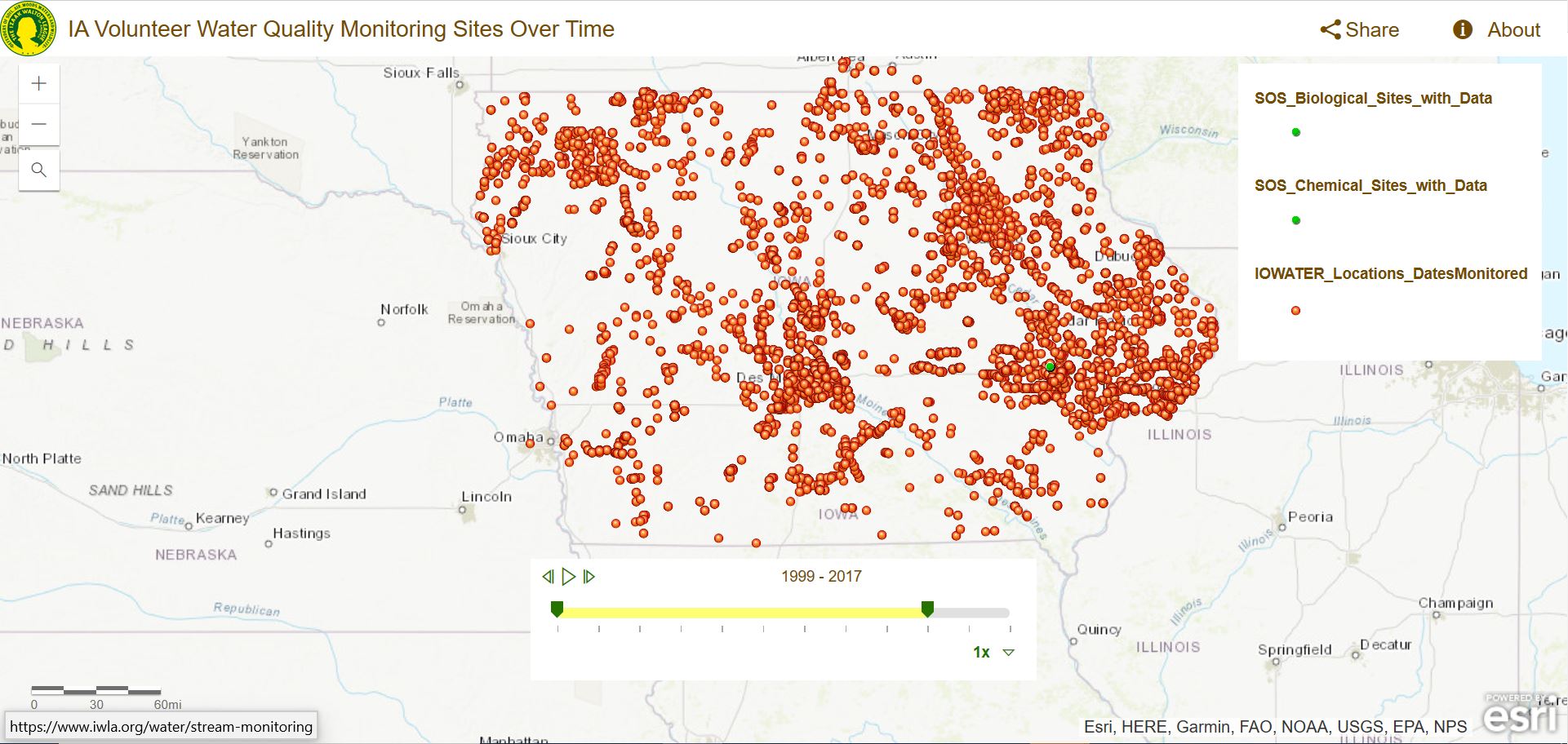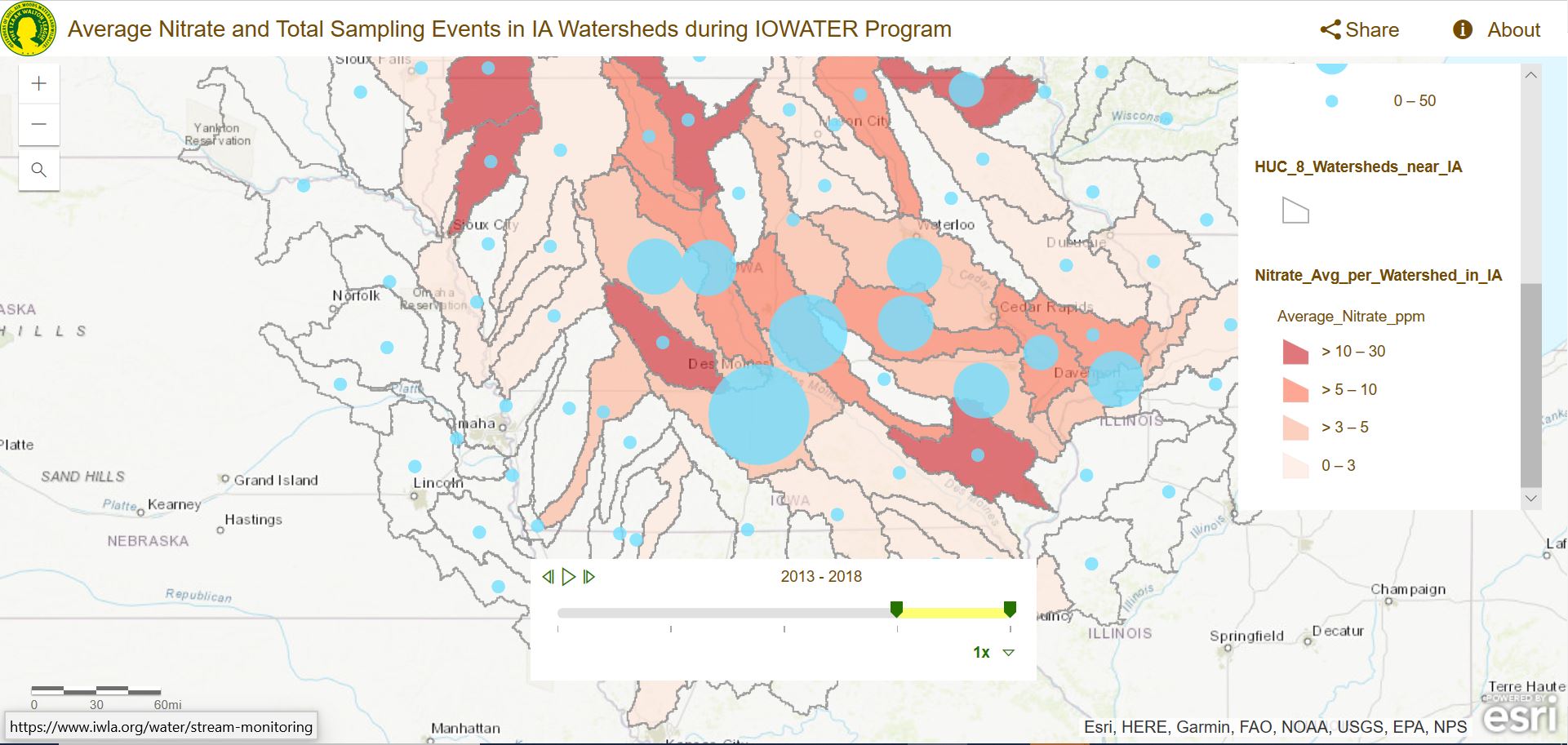Iowa
Iowa has some of the richest and most productive soil in the world. In fact, over 85% of Iowa land is used for agriculture, which produces billions of dollars of exports annually for the state’s economy. Iowa ranks first in the United States in corn, hog, and egg production and second in soybean and red meat production. The use of Iowa’s productive natural resources comes at a cost, however. Water quality issues, poor soil health, and decreased wildlife habitat are external costs that result from unsustainable land use in Iowa.
Volunteer Water Quality Monitoring in Iowa
IOWATER was a volunteer water quality monitoring program of the Iowa Department of Natural Resources that ran from 1999-2017. Under IOWATER, volunteers monitored thousands of sites and produced tens of thousands of data points all over the state. IOWATER ended after 2017, with nearly twenty years of data collected by Iowans.
Consistent and sustained monitoring is crucial to identify trends in data, establish a normal baseline, and detect water pollution problems when they arise. The Izaak Walton League’s Save Our Streams program is stepping up to create a new statewide volunteer water quality monitoring program in Iowa. The Save Our Streams program has been at work around the country since 1969, and in 2019, IWLA began a concentrated effort to train and coordinate volunteer stream monitors in Iowa. As we train more volunteers, we will have more Iowa sites and data included on the Clean Water Hub to keep an eye on Iowa’s water quality now and in the future.
The map below shows the magnitude of monitoring that occurred during the nearly twenty years of IOWATER – and where Save Our Streams volunteers are putting water quality monitoring back on the map! Click the image to go to the interactive map, then move the slider or click the Play button at the bottom to see how the monitoring programs have grown and changed over time.

Water Quality in Iowa
One of the parameters measured by IOWATER volunteers was nitrate. Nitrate occurs naturally in low concentrations, but excessive nitrate in water can cause environmental and human health risks. Nitrogen is typically the most abundant nutrient in chemical fertilizers used on farm fields, lawns, golf courses, and gardens, and this nitrogen becomes nitrate as it moves through the environment. Sewage, faulty septic systems, and animal feedlots can also be big contributors of nitrate.
This map shows the watersheds in Iowa. (A watershed is the land area that drains into a specific stream or other water body.) Darker red watersheds were found to have more nitrate. A bigger blue dot in a watershed means the nitrate data is based on more monitoring. Click the image to go to the interactive map, then move the slider at the bottom to see how nitrates changed over different time periods.
From this map, we can see that nitrate levels were problematic in many parts of Iowa throughout the 19 years of the IOWATER program – and in the final five years, the situation has gotten worse.

What’s Hurting Water Quality in Iowa?
Iowa is faced with myriad water quality issues, including sedimentation as a result of soil erosion, excessive nutrient loads from chemical fertilizers, and dangerously high fecal bacteria levels. Iowa’s poor water quality can lead to harmful algae blooms, fish kills, and human health problems from recreating in and drinking polluted water.
Many of Iowa’s water quality problems can be traced to poor soil health, excessive application of agricultural chemicals, and manure spills and leaks from commercial animal feedlots. Urban areas do contribute to water pollution as well, but Iowa has a relatively small population and urban areas make up only a small portion of Iowa’s landscape.
Iowa has one of the most altered landscapes in the world. Wetlands have been drained, streams have been straightened and diverted, streamside habitats have been shrunk or altered, and more than 99.9% of Iowa’s native prairies have been plowed under to make more space on the landscape for productive farms. Without these natural habitats to slow down and filter water and retain healthy topsoil, pollutants from the land can readily find their way into Iowa’s lakes and rivers. Additionally, the loss of habitat has created profound negative impacts on native wildlife populations, both on the land and in the water.
What You Can Do
IOWATER data indicated some concerning trends in Iowa’s water pollution problems. One of the most important takeaways from this data is that we need more volunteers consistently monitoring Iowa’s streams and sharing their valuable water quality observations with the public. There have been many diverse approaches to addressing Iowa’s water pollution and soil health problems. However, it is difficult to reliably track the progress of these practices without more people monitoring our streams. You can help.
Become a volunteer stream monitor
Share your data
Support our volunteer stream monitors
Learn more about our work for sustainable agriculture